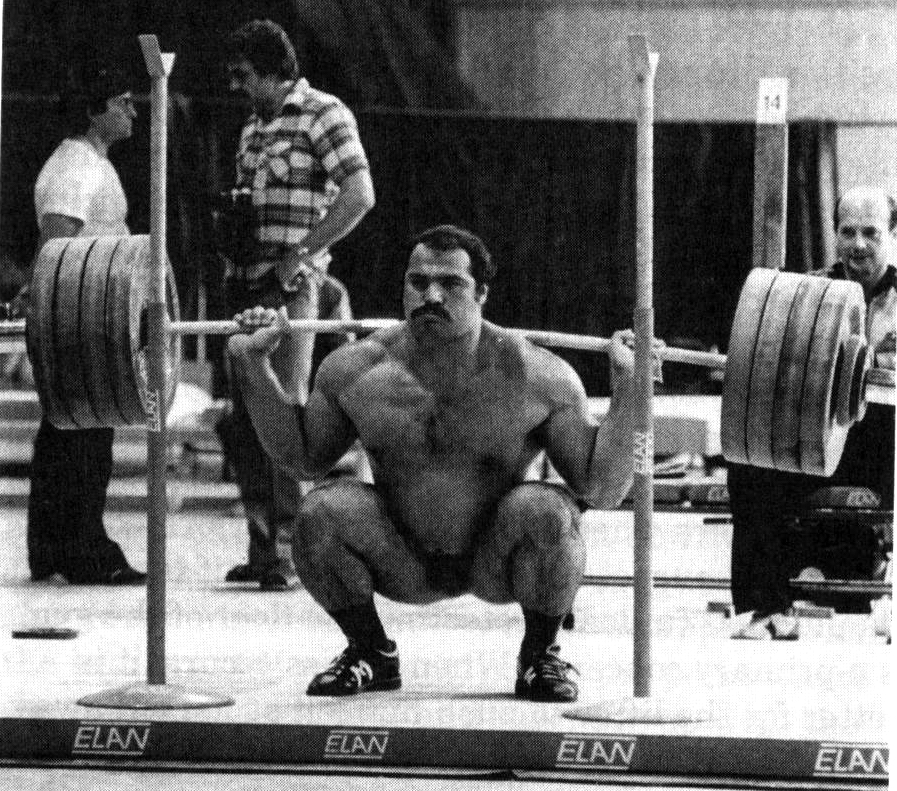All the extra hours you spent in the gym and all the super heavy weights you have been lifting have actually been holding you back.
What I am about to tell you is the equivalent of me saying to study less and get higher grades. For those of you with a job, it is like me saying to work less and make more money.
It seems completely ludicrous (unless you are Tim Ferriss), but it's true.
After 15 years of research and experimentation, I believe I have found the Holy Grail of Strength.
If you follow this Holy Grail, these are the results you can have ...
20lb increase on bench ...
30lb increase on deadlift ...
40lb increase on squat ...
... In 3 Weeks!!!
If you can get gainz like that from your current program, you are either a liar, on some serious "supplements", or you just finished training like or with me.
(Note: This excludes novice lifters who make huge gains simply by learning technique and motor patterns. The gains you see above are for experienced lifters who have had over a year of training in an elite program.)
The Program
The "Holy Grail of Strength" Program is simple.
- Train 3 days per week
- Bench, Squat and Deadlift all 3 days
- Do 2 sets of 5 reps for each movement
- Start with 70% of your projected one rep max
- Add 5lbs to each lift every training day.
Example
- Projected 1 Rep Max for Bench Press = 315lbs
- Projected Started Training Weight = 220lbs (70% of 315)
- Day 1 --> 2 sets of 5 @ 220lbs
- Day 2 --> 2 sets of 5 @ 225lbs
- Day 3 --> 2 sets of 5 @ 230lbs
- Continue this progression to Day 9, which will leave you at 2 sets of 5 @260lbs
- Do the same exact progress and rep scheme for Squat and Deadlift
The Principles
The frequency of the lifts, the load, and the rep schemes are based on the following strength training principles:
1. Intramuscular tension (effort of the muscle necessary to produce a certain force output).
The 70% starting weight makes the load heavy enough to influence intramuscular tension, but light enough not kill the joints and prevent recovery. Remember, the recovery time between lifts is 1-2 days (not 7), as we are benching, squatting, and deadlifting 3 times a week.
2. Time Under Tension (TUT) (total time a muscle is under tension)
 |
| Not to be confused with King Tut ... |
In many programs, TUT is measured by how long a given set lasts. For example, you can increase the TUT for a set of bench press by taking 8-10 seconds to lower the bar on each rep as opposed to 2-4 seconds.
In the Holy Grail, we focus more on the Cumulative TUT for all of our sets, not just one. And by cumulative sets, I mean all the sets we do over a given week.
By benching, squatting, and deadlifting every day, we automatically increase our cumulative TUT.
3. Optimizing Motor Patterns (ability to activate muscles to enable efficient movements)

By repeating the same movements at a sub-maximal load (~70%) at each training session, we are able to use each session as "practice" to focus on activating the motor units that enable efficient movement patterns.
Many industry experts refer to this as "smooth the groove".
In college, my linebacker coach called it "muscle memory".
Regardless of what you call it, the more often you practice proper technique, the better chance you will have to execute properly.
This coincides nicely with using sub-maximal loads, as I am not sure our bodies would recovery adequately if we were going at >90% of our max. In addition, I truly believe that most people at >90% loads compromise their form ... thereby destroying their motor pattern development.
THE HATERS
It is around this time that "The Haters" are going to start calling me out on all of the deficiencies in the program.
 |
So ... I am going to use a lesson I learned in one of the greatest American films of all-time, 8 Mile, and call myself out before any of you can try to embarrass me.

Wouldn't I get stronger by lifting >85% of my one rep max?
If we were talking about one training session, the answer is "Yes". The more weight you use, the further to the left on the force velocity curve you would move.
Working with 100% of your max would put you at the "maximal strength" point.
Working at 70% puts you somewhere in the range of the "strength-speed" point.
Nevertheless, working at 100% would require much more recovery time and would not allow you complete as many repetitions over the course of the week.
If you actually read my points above, you would see how these increased repetitions enable increased TUT (point #2) and the optimization of movement patterns (point #3).
If you are a meat head and feel less manly any time you are not "maxing out", then take a look at the two examples below.
You will notice the second example (the Holy Grail method) allows you to move 210% more weight over a given week.
Example 1: Performing 10 reps of 100% max 1 time per week (with a projected one rep max of 315lbs)
- 10 reps * 1 time per week * 315lbs per rep = 3150lbs per week
Example 2: Performing 10 reps of 70% max 3 times per week (with a projected one rep max of 315lbs)
- 10 reps * 3 time per week * 220lbs per rep = 6600lbs per week
Note to the Haters: Yes ... you could bench 100lbs, 100 times a day, 3 times a week and move 30,000lbs per week. But doing so would put you very far to the right on the curve above, taking a great deal of the strength element out of the game.
2nd Note to the Haters: Do you even think example number 1 is even possible?
I play football. Don't I need to work on my explosion and not just power lifting?
Absolutely.
In my world, I would refer to these as power movements and speed movements (which are further to the right on the curve).
For power, I would add in 2-3 sets of light Olympic Lifts (i.e hang clean) or Plyometrics (i.e broad jump) each day.
For speed, I would add in a sprinting session 1x per week.
Note to the Haters: Do not go max effort on your Olympic lifts. It ultimately leads to poor form, slow movements, and zero execution of the triple extension of the ankle, knee, and hip that is supposed to "carry over" into your sport.
 |
| You rarely see this triple extension in high school kids |
What about addressing muscular imbalances? Aren't you a mobility, stabilization, anti-injury geek?
Anyone who knows me knows that I love to incorporate pre-hab and mobility movements into each and every one of our sessions.
As part of the Holy Grail, I would incorporate a pre-hab or mobility drill in between every set of squat, bench and deadlift.
Not only will it stop your crew from talking in between sets, it will turn all of them into Supple Leopards.
 |
| Kelly Starrett is a game changer ... |
What about ancillary lifts? Don't we need other movements to help improve bench, squat, and deadlift?
Because of the frequency of those lifts and the daily mobility drills, you will need very few ancillary lifts to support the big 3 we are focusing on.
For example, do you really need to work on grip strength if you are going to deadlift every day?
Having said that, I recommend doing one ancillary lift every day. That lift should be no more than 2 sets and should be of high volume.
I am doing this for 2 reasons.
1. The ancillary lift can help with muscle imbalances. For example, it wouldn't hurt to throw in some rows to to balance out all the bench we will be doing.
2. The higher volume work will help us in the size department, as it moves us into the hypertrophy zone.

I am a realist, so I am not going to give you the ole, "Well if getting insanely strong is boring, then you are reading the wrong blog" routine.
Doing the same 3 lifts every day is eventually going to get boring.
 |
| It's Groundhog Day !!! |
1. Change up the type of bench, squat, and deadlift every few months. For example, you can go from a flat bench to an incline bench or you can go from a sumo deadlift to an RDL.
2. Utilize various pre-hab drills, power movements, and ancillary lifts in between your bench, squat, and deadlift sets.
3. Have a deload every 4th week, where you incorporate completely different movement patterns.
Isn't the first lift at 70% going to feel like a joke? I am probably going to have to do an extra workout on my own just to feel anything.
You are correct.
Working with 70% on your first day is going to feel relatively easy.
In fact, if you only add 5lbs a day for 3 weeks, every workout is going to feel relatively easy.
That is the point.
Much like the frog on the frying pan anecdote, the slow, incremental increases in load are intended to make you feel like no changes are occurring at all.

We want each session to feel easy, so we can focus on intramuscular tension and optimized moving patterns.
Remember, we want every session to feel like a practice, rather than an excruciating workout.
If the session feels too easy, simply squeeze the barbell tighter or increase your time under tension (TUT).
Your joints will thank you for it.
Special Notes
1. The first time we implemented this Holy Grail, we had incredible gains, but people felt horribly sore. The soreness was an error on my part, as I went too high with the starting weight (using 80% of a projected one rep max instead of 70%).
2. These concepts were introduced to me when I studied the works of Christain Thibaudeau and Pavel Tsatsouline. I read their respective works The Black Book of Training Secrets and Power to the People right after I got out of college in 2001. Unfortunately, I tried to get to "cutting edge" with my training and never stuck to their true principles. It wasn't until I heard Pavel on Tim Ferriss' podcast, that I realized how stupidly I had been training / coaching over the past 15 years.
Coming soon
I have been getting several questions the Holy Grail, so expect to see a few more blogs on this topic.
Here are some things we will cover ...
1. What was the exact program used by the experimental group?
2. Did that group have a pre-test and a post test?
3. What calculations did I use to determine their gains?
4. Why did I use more than 70% as their starting weight?
5. Did anyone hit a wall early and if so, what did I do?
6. How do you turn this program from a 3 week program into a 16 week program?
7. How does this tie into the survey you sent out a few months ago asking us for our Top 10 Strength Program Requirements.





No comments:
Post a Comment